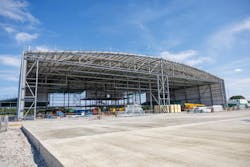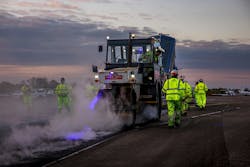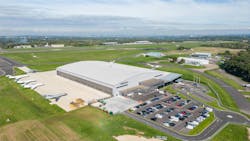How London Biggin Hill Service Centre Drives MRO Excellence: From Its New Paint Facility to OEM Aftermarket Support
Key Highlights
- London Biggin Hill Service Centre's new paint facility spans 51,000 square feet with two bays and integrates with existing maintenance services, enabling aircraft to be maintained, painted and refurbished on-site.
- London Biggin Hill's strategic location and infrastructure support efficient MRO operations, attracting aviation companies and enabling quick turnaround times for aircraft maintenance.
- The facility supports OEM aftermarket strategies by providing adaptable, modern infrastructure that meets sustainability goals, such as trials of renewable materials like Bio-Bitumen, ensuring long-term industry resilience.
As Bombardier’s new paint facility at London Biggin Hill Service Centre prepares to launch in 2026, benefits like enhanced aircraft services offerings, more open roles for skilled workers and opportunities to stimulate the broader MRO ecosystem abound.
Aviation Pros talks with Robert Walters, commercial director at London Biggin Hill Airport (BQH), to learn about why the new paint facility is especially exciting and how Bombardier’s service center helps drive improvement of OEM aftermarket strategies and MRO support.
What to know about London Biggin Hill Service Centre’s new paint facility
Walters speaks on the excitement surrounding the rapidly progressing paint facility at London Biggin Hill Service Centre, stating, “The most exciting part is the investment itself. Bombardier’s two-bay, 51,000-square-foott facility is a major enhancement to the services already available on site.”
“It’s also a symbol of how London Biggin Hill continues to evolve—adding new capabilities and reinforcing our role as a dedicated hub for business aviation operations,” adds Walters.
Discussing the new services being added to Bombardier’s offerings, Walters notes that the painting facility will be capable of accommodating all of Bombardier’s aircraft types, including:
- Global
- Challenger
- Learjet
Walters says, “It has been designed to deliver world-class exterior painting and refinishing, ensuring operators receive the highest level of technical quality and craftsmanship that customers expect from Bombardier.”
Aside from adding new painting capabilities, Walters highlights how the paint facility will complement London Biggin Hill Service Centre’s current services, sharing, “The Service Centre already provides comprehensive maintenance, inspection and interior refurbishment services within its 250,000-square-foot facility.”
He continues, “With the addition of a dedicated paint facility, operators and owners will be able to have aircraft maintained, refurbished and repainted without having to leave London Biggin Hill Airport. This in turn reduces downtime, simplifies logistics, saves costs and ensures greater efficiency.”
Walters also emphasizes how Bombardier’s investment in the facility contributes to the broader MRO ecosystem. He notes, “An investment of this scale has a ripple effect. It stimulates local supply chains, attracts new specialist businesses and embeds long-term capability in the region.”
“For London Biggin Hill, it reinforces our position as a leading hub for MRO activity and demonstrates how close collaboration between OEMs and dedicated business aviation airports helps accelerate innovation, expand opportunities for skilled workers and enhance overall service quality,” says Walters.
Why is London Biggin Hill Service Centre significant for MROs?
A significant strength of Bombardier’s service center at London Biggin Hill Airport is its status as a strategic hub for MRO services in the region.
When asked about why this is, Walters answers, “The London Biggin Hill Service Centre is strategically located for global MRO operations. The airport is also home to more than 70 aviation and engineering companies, making it a key hub for MRO activity.”
He adds, “For OEMs and operators, the base offers both the infrastructure and the specialist community needed to deliver effective and efficient operations. Aircraft can arrive for inspections and depart with multiple workstreams complete, from maintenance to interior refresh and painting.”
Walters continues, “That integrated model improves turnaround, reduces complexity and gives operators greater schedule certainty. More broadly, it reflects how dedicated business aviation airports are evolving to bring services, skills and innovation together on a single site.”
How will Bombardier’s new paint facility benefit skilled workers and maintenance technicians?
With new services at London Biggin Hill’s Service Centre comes new opportunities and benefits for local skilled workers and technicians in aircraft maintenance.
Walters notes, “The most immediate benefit is the creation of valued, long-term positions, with more than 50 new highly skilled roles generated within the facility. Equally important, however, is how it expands opportunities for apprenticeships and training, ensuring local talent have clear pathways into aerospace careers.”
He adds, “Through initiatives like our bi-annual Futures Week and partnerships with local schools, we are inspiring the next generation to consider the wide range of careers available in aviation. Over time, this kind of development also strengthens the wider supply chain, creating openings for skilled workers in related industries.”
“It strengthens our aerospace community and provides long-term careers in an industry where expertise is in high demand,” says Walters, touching on the shortage of AMTs and skilled workers across the aviation sector.
How does the London Biggin Hill Service Centre benefit OEMs and aftermarket strategies?
As the London Biggin Hill Service Centre operates within an airport, it showcases how modern airport infrastructure—namely at business aviation airports—provides critical support to OEM aftermarket strategies.
According to Walters, “OEM aftermarket strategies depend on modern infrastructure. Without reliable hangars, runway availability and specialist facilities, OEMs cannot deliver the efficiency and service quality their customers demand.”
Walters continues, “Equally important is adaptability—ensuring facilities evolve to align with operators’ and OEMs’ changing needs, from enhancing capacity to meeting sustainability commitments.”
“Current projects at London Biggin Hill, such as advanced runway resurfacing and trials of renewable materials like Bio-Bitumen, provide confidence that their long-term investment is well supported, with infrastructure designed to meet the demands of modern aviation,” he adds.
Another aspect of the service center and new paint facility that supports collaboration with OEMs and overall maintenance efficiency is its function as a one-stop-shop MRO.
Walters notes, “One of the defining strengths of a one-stop-shop MRO ecosystem is the way it brings different parts of the supply chain into close proximity, encouraging innovation, collaboration and knowledge sharing.”
“For OEMs, this means their customers benefit from a smoother experience and consistently high standards across every aspect of maintenance. Instead of dealing with fragmented providers spread across multiple sites, they operate within a connected hub where expertise is always close at hand,” he elaborates.
Walters says, “The result is not only faster turnaround times, but also greater reliability and a higher overall quality of service, which ultimately strengthens customer confidence.”
How are London Biggin Hill Service Centre and Bombardier navigating operations amid economic uncertainty?
In an era where economic uncertainty seems near constant, with issues like tariffs in aviation being a common topic, Bombardier and London Biggin Hill Service Centre are maintaining performance by adjusting to developing industry needs.
Walters explains, “Performance has been maintained by focusing on what the industry needs most: efficiency, reliability and confidence. Aircraft maintenance is not something that can be delayed, and operators value the certainty of having trusted facilities and skilled technicians available to keep their fleets operational. That is why demand for such services at London Biggin Hill has remained strong.”
He continues, “Bombardier’s decision to expand here, even during challenging economic conditions, is a positive indication of its trust in both the strength of the European market and the collaborative ecosystem we have built at the airport.”
“It reflects the resilience of the sector and the airport’s ability to provide an environment where OEMs and MROs can continue to thrive,” concludes Walters.





